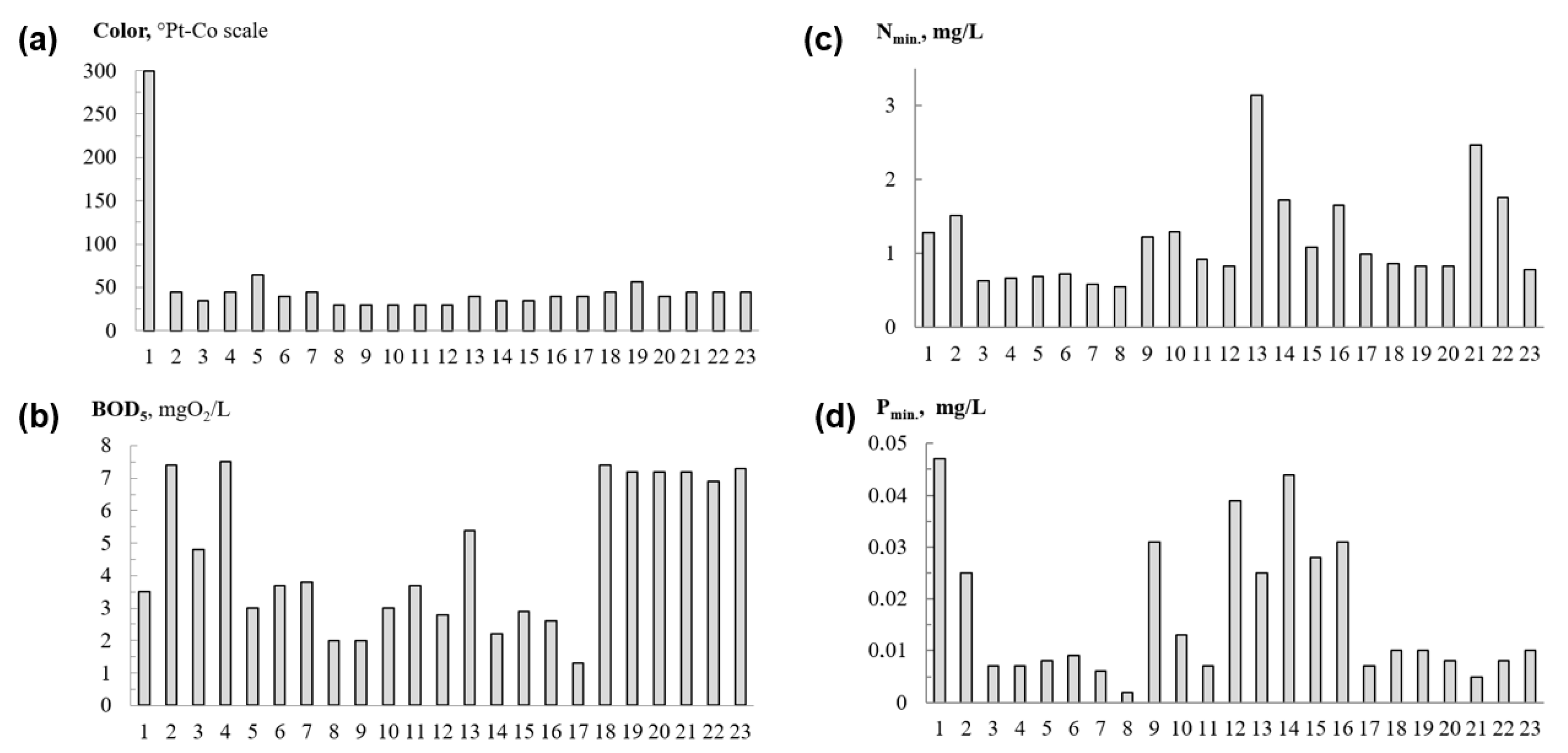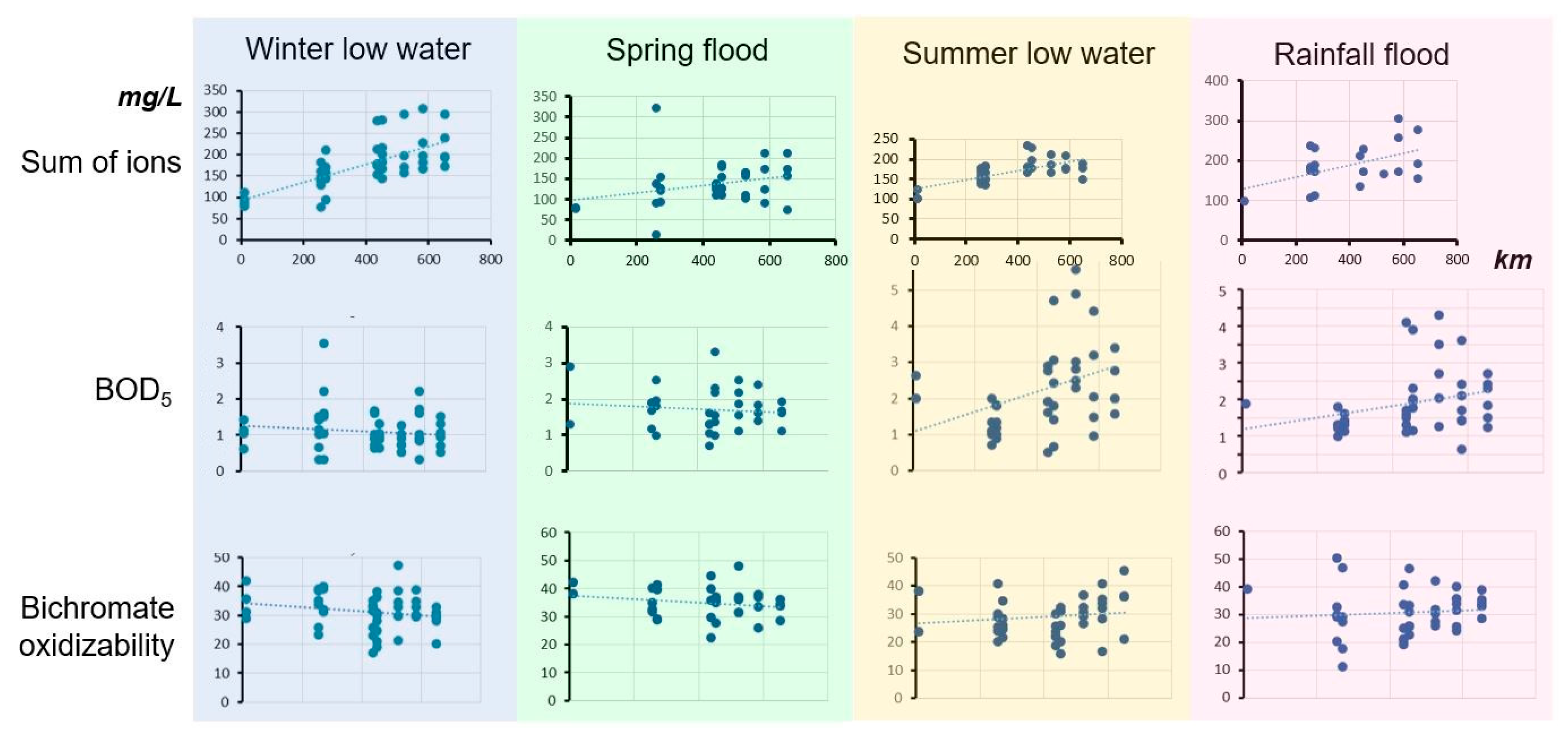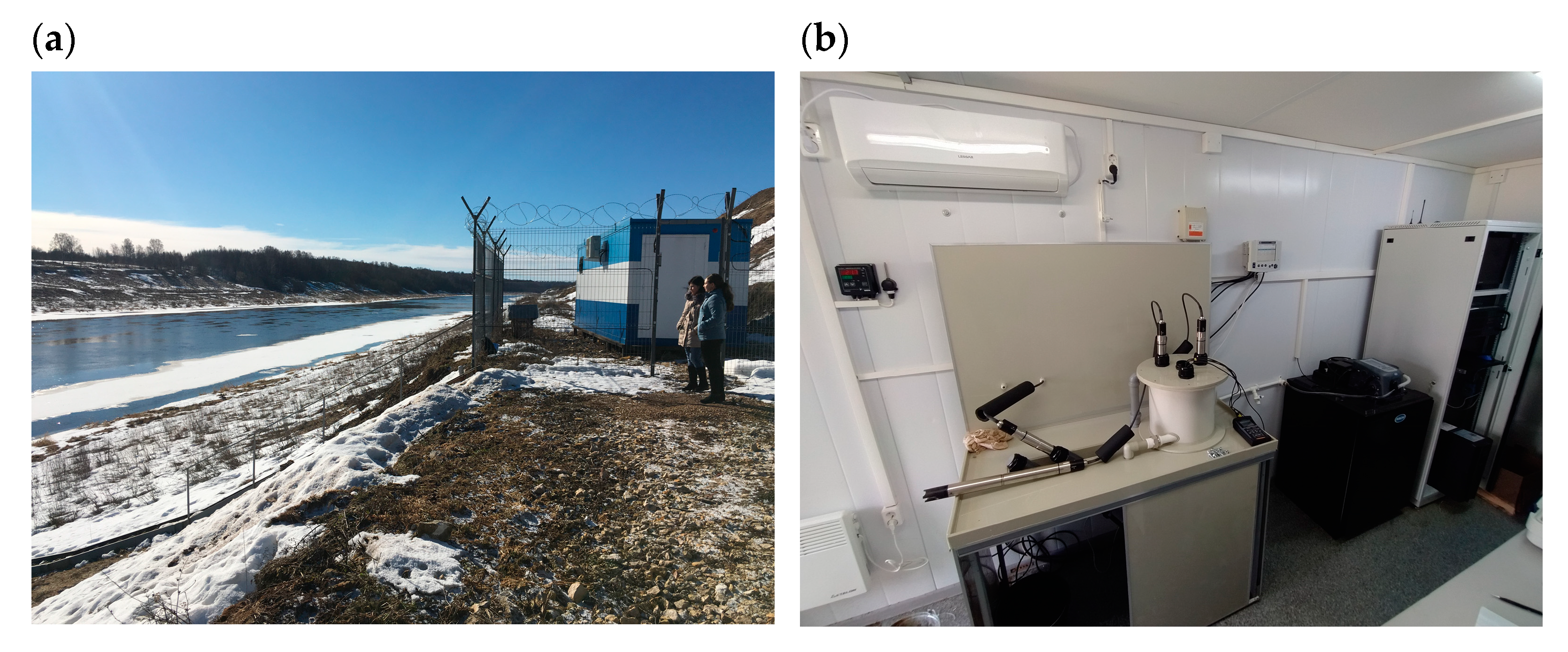Water Quality Monitoring in the Volga Headwaters
Abstract
:1. Introduction
2. Materials and Methods
2.1. Research Area
2.2. Sampling and Data Analyses
3. Results
3.1. Hydrochemical Characteristics of the Upper Volga in Summer Low-Flow Period
3.2. Temporal and Spatial Variability of Hydrochemical Parameters
3.3. The Problem of “Natural Pollution”
3.4. Changes in the Content of Biogenic Elements and Indicators of Organic Matter in the Water of the Ivankovskoye Reservoir over a Long-Term Period
4. Discussion
5. Conclusions
Supplementary Materials
Author Contributions
Funding
Data Availability Statement
Acknowledgments
Conflicts of Interest
References
- Meran, G.; Siehlow, M.; von Hirschhausen, C. Water Availability: A Hydrological View. In The Economics of Water; Meran, G., Siehlow, M., von Hirschhausen, C., Eds.; Springer Water: Cham, Switzerland; Berlin/Heidelberg, Germany, 2021; pp. 9–21. [Google Scholar]
- Shiklomanov, I.A. World Water Resources: A New Appraisal and Assessment for the 21st Century; United Nations Educational, Scientific and Cultural Organization: Paris, France, 1998; pp. 1–40. [Google Scholar]
- Alley, W.M.; Healy, R.W.; LaBaugh, J.W.; Reilly, T.E. Flow and Storage in Groundwater Systems. Science 2002, 296, 1985–1990. [Google Scholar] [CrossRef]
- Portner, K.M. Cooperative riverfront planning: The Colorado river, Grand Junction, Colorado. Can. Water Resour. J. 1992, 17, 264–269. [Google Scholar] [CrossRef]
- Mendelsohn, J.; El Obeid, S. Okavango River-The Flow of a Lifeline; Struik Publishers: Cape Town, South Africa, 2004; pp. 1–176. [Google Scholar]
- Wymenga, E.; van der Kamp, J.; Fofana, B.; Zwarts, L. Ecological evaluation of dams and irrigation in the Upper Niger. In The Niger, a Lifeline. Effective Water Management in the Upper Niger Basin; Zwarts, L., van Beukering, P., Kone, B., Wymenga, E., Eds.; Tienkamp & Verhey: Vlaardingen, The Netherlands, 2005; pp. 211–223. [Google Scholar]
- Taïbi, A.N.; Kane, A.; Bourlet, M.; Lorin, M.; Ballouche, A. The Senegal River, a Disturbed Lifeline in the Sahel. In River Culture–Life as a Dance to the Rhythm of the Waters; Wantzen, K.M., Ed.; UNESCO Publishing: Paris, France, 2023; pp. 79–113. [Google Scholar]
- Kashchenko, O.; French, M. The Volga River: Russia’s Strained Lifeline. 2005. Available online: http://www.cabri-volga.org/DOC/CabriVolgaBriefIssue1.pdf (accessed on 18 November 2023).
- Kruse, J.; Fellin, L.; Fuller, S.; Womack, A. Analyses of the Upper Mississippi and Illinois Rivers as Grain Transport Arteries: A Spatial Equilibrium Analyses. In Proceedings of the 48th Annual Transportation Research Forum, Boston, MA, USA, 15–17 March 2007. [Google Scholar]
- de Villeneuve, C.H.V. Western Europe’s Artery: The Rhine. Nat. Resour. J. 1996, 36, 441–454. [Google Scholar]
- Denisov, N. The Artery of Eastern Ukraine. Summary of the Analysis of Water Issues in the Siverskyi Donets River and Programme of Measures to Address Them; Vaite LLC: Kyiv, Ukraine, 2021; pp. 1–102. [Google Scholar]
- Clark, C.; Emmanouil, N.; Page, J.; Pelizzon, A. Can You Hear the Rivers Sing? Legal Personhood, Ontology, and the Nitty Gritty of Governance. Ecol. Law Q. 2019, 45, 787–844. [Google Scholar]
- Boccaletti, G. Water: A Biography; Pantheon: New York, NY, USA, 2021; pp. 1–400. [Google Scholar]
- Salati, E.; Dall’Olio, A.; Matsui, E.; Gat, J.R. Recycling of water in the Amazon Basin: An isotopic study. Water Resour. Res. 1979, 15, 1250–1258. [Google Scholar] [CrossRef]
- van der Ent, R.J.; Savenije, H.H.G.; Schaefli, B.; Steele-Dunne, S.C. Origin and fate of atmospheric moisture over continents. Water Resour. Res. 2010, 46, W09525. [Google Scholar] [CrossRef]
- Makarieva, A.M.; Gorshkov, V.G. Biotic pump of atmospheric moisture as driver of the hydrological cycle on land. Hydrol. Earth Syst. Sci. 2007, 11, 1013–1033. [Google Scholar] [CrossRef]
- Oltchev, A.; Cermak, J.; Gurtz, J.; Tishenko, A.A.; Kiely, G.; Nadezhdina, N.; Zappa, M.; Lebedeva, N.; Vitvar, T.; Albertson, J.D.; et al. The response of the water fluxes of the boreal forest region at the Volga’s source area to climatic and land-use changes. Phys. Chem. Earth Parts A B C 2002, 27, 675–690. [Google Scholar] [CrossRef]
- Schletterer, M.; Füreder, L.; Kuzovlev, V.V.; Zhenikov, Y.N.; Grigorieva, I.L. Lowland river reference condition: Spatial and temporal patterns of the zoobenthos community in the Volga headwaters (2006–2010). Hydrobiologia 2014, 729, 175–189. [Google Scholar] [CrossRef]
- The 17 Goals. Available online: https://sdgs.un.org/goals (accessed on 18 November 2023).
- RD 52.24.309-2016; Regulatory Document: Organization and Conduct of Regime Observations of the State and Pollution of Surface Land Waters. Publishing House of the Meteorological Agency Roshydromet: Moscow, Russia, 2016; 104p.
- Nikanorov, A.M. Hydrochemistry; NOK: Rostov-on-Don, Russia, 2008; 462p. [Google Scholar]
- Pavluk, T.I.; Bij de Vaate, A.; Leslie, H.A. Development of an Index of Trophic Completeness for benthic macroinvertebrate communities in flowing waters. Hydrobiologia 2000, 427, 135–141. [Google Scholar] [CrossRef]
- Bartram, J.; Balance, R. (Eds.) Water Quality Monitoring. A Practical Guide to the Design and Implementation of Freshwater Quality Studies and Monitoring Programmes; F & FN Spon Ltd.: London, UK, 1996; pp. 1–400. [Google Scholar]
- Butorin, N.V. (Ed.) Volga i Eyo Zhizn (The Volga and Its Life); Nauka: Leningrad, Russia, 1978; 350p. [Google Scholar]
- Mineeva, N.; Lazareva, V.; Litvinov, A.; Stepanova, I.; Chuiko, G.; Papchenkov, V.; Korneva, L.; Shcherbina, G.; Pryanichnikova, E.; Perova, S.; et al. Chapter 2-The Volga River. In Rivers of Europe, 2nd ed.; Tockner, K., Zarfl, C., Robinson, C.T., Eds.; Elsevier Ltd.: Amsterdam, The Netherlands, 2022; pp. 27–79. [Google Scholar]
- Grigoryeva, I.L.; Lantsova, I.V.; Tulyakova, G.V. Geoekologiya Ivan’kovskogo Vodokhranilishcha i ego Vodosbora (Geoecology of the Ivan’kovo Reservoir and Its Drainage Basin); Bulat: Tver, Russia, 2000; 248p. [Google Scholar]
- Butorin, N.V. (Ed.) Ivankovskoye vodokhranilishche i ego zhizn. Tr. Inst. Biol. Vnutr. Vod. AN SSSR 1978, 34, 1–304. [Google Scholar]
- Grishantseva, E.S.; Safronova, N.S. Ecological-geochemical assessment of the state of the Volga source of water supply to Moscow. Water Resour. 2012, 39, 305–321. [Google Scholar] [CrossRef]
- Hydrometeorological Regime of Lakes and Reservoirs in the USSR: Upper Volga Reservoirs; Gidrometeoizdat: Leningrad, Russia, 1975; 291p.
- Gosudarstvennyi Doklad o Sostoyanii Okruzhayushchei Sredy na Territorii Tverskoi Oblasti v 2010 g. (State Report on the Environmental Conditions in Tver Province in 2010), Tver, 2011. Available online: https://minpriroda.tverreg.ru/deyatelnost-iogv/napravleniya/okhrana-okruzhayushchey-sredy/ (accessed on 29 December 2023).
- The Quality of Surface Waters of the Russian Federation. The Yearbook 2021. Rostov-on-Don, The State Hydrochemical Institute of Roshydromet, 2022, 620p. Available online: https://gidrohim.com/node/44 (accessed on 29 December 2023).
- RD 52.18.595-96. Federal List of Measurement Techniques Permitted for Use in the Monitoring of Environmental Pollution, 1998; 48p. Available online: https://meganorm.ru/Data2/1/4293824/4293824448.pdf (accessed on 14 January 2024). (In Russian)
- Kurlov, M.G.; Sobkevich, A.I. Opyt Klassifikatsii Sibirskikh Tselebnykh Mineral’nykh Vod, Soglasno Khimicheskomu Ikh Sostavu. Tomsk, USSR, Tomskogo Gubernskogo Otdeleniya Gosizdatelstva. 1921. Available online: http://vital.lib.tsu.ru/vital/access/manager/Repository/vtls:000396437 (accessed on 7 April 2021).
- Schletterer, M.; Füreder, L.; Kuzovlev, V.V.; Zhenikov, K.Y.; Zhenikov, Y.N. REFCOND_ VOLGA: A monitoring programme for water quality in the headwaters of the Volga River (Tver region, Russia). Rev. Eletrônica De Gestão E Tecnol. Ambient. GESTA 2016, 4, 18–40. [Google Scholar]
- Zhenikhov, K.Y.; Kuzovlev, V.V.; Zhenikhov, Y.N.; Schletterer, M. The study of the relationships between indicators of surface water quality in wetland catchments: A case study of the Tudovka River in the Tver Region. Geoekologia 2019, 3, 68–76. [Google Scholar]
- Naydenova, V.I. Hydrochemical Characteristics of Medium and Large Rivers of the European Territory of the USSR; Voronkov, P.P., Ed.; Gidrometeoizdat: Leningrad, Russia, 1971; 296p. [Google Scholar]
- R 52.24.862-2017; Recommendation: Choice of Permissible Fluctuation Limits of Informative Hydrochemical Indicators of the State of River Ecological Systems Located in Various Climatic Conditions. Roshydromet: Rostov-on-Don, Russia, 2017; 18p.
- RD.52.24.661–2004; Regulatory document: Assessment of the Risk of Anthropogenic Impact of Priority Pollutants on the Surface Waters of the Land. Publishing House of the Meteorological Agency Roshydromet: Moscow, Russia, 2006; 26p.
- Kudryavtsev, D.D. Comparative characteristics of the hydrochemical regime of the Upper Volga reservoirs: Ivankovo, Uglich and Rybinsk. Proc. Borok Biol. Stn. 1950, 1, 80–96. [Google Scholar]
- Grigoryeva, I.L.; Komissarov, A.B.; Chekmareva, E.A. Transformation of the water quality of the Ivankovo reservoir and its small tributaries over a long period under the in-fluence of natural and anthropogenic factors. Quest. Geogr. 2018, 145, 337–346. [Google Scholar]
- Debolsky, V.K.; Kocharyan, A.G.; Grigoryeva, I.L.; Lebedeva, I.P.; Tolkachev, G.Y. Problems of water quality formation in surface water supply sources and ways to solve them using the example of the Ivankovo reservoir. Water Chem. Ecol. 2009, 7, 2–11. [Google Scholar]
- Kuzovlev, V.V.; Schletterer, M. Limnological characterization of the sources of Volga, Dnieper & Western Dvina (Daugava). Glob. J. Ecol. 2022, 7, 072–076. [Google Scholar]
- The Method of Integrated Assessment of the Degree of Pollution of Surface Waters by Hydrochemical Indicators; Publishing House of the Meteorological Agency Roshydromet: Moscow, Russia, 2002; 55p.
- Komissarov, A.V. Phytoplankton of the unregulated Upper Volga River. In Algae: Problems of Taxonomy, Ecology and Use in Monitoring; Voloshko, L.N., Ed.; Renome: St. Petersburg, Russia, 2018; pp. 238–241. [Google Scholar]
- Schletterer, M.; Weiss, S.J.; Kuzovlev, V.V.; Vitecek, S.; Borgwardt, F.; Graf, W. The rare and enigmatic mayfly Prosopistoma pennigerum (Müller, 1785): Habitat characteristics, recent records from the Volga (Russia) and Vjosa (Albania) rivers, and a proposal for flagship species status. Aquat. Conserv. Mar. Freshw. Ecosyst. 2021, 31, 3636–3643. [Google Scholar] [CrossRef] [PubMed]
- Harvey, R.; Lye, L.; Khan, A. Recent Advances in the Analysis of Real-time Water Quality Data Collected in Newfoundland and Labrador. Can. Water Resour. J. Rev. Can. Des Ressour. Hydr. 2011, 36, 349–361. [Google Scholar] [CrossRef]
- Mijović, S.; Palmar, B. Water quality monitoring automation of rivers in Serbia. In FACTA UNIVERSITATIS, Series: Working and Living Environmental Protection; 2012; Volume 9, pp. 1–10. Available online: https://tarjomefa.com/wp-content/uploads/2016/02/4367-engilish.pdf (accessed on 30 December 2023).
- Heikkinen, K. Seasonal-changes in iron transport and nature of dissolved organic-matter in a humic river in northern Finland. Earth Surf. Process. Landf. 1990, 15, 583–596. [Google Scholar] [CrossRef]
- Abesser, C.; Robinson, R.; Soulsby, C. Iron and manganese cycling in the storm runoff of a Scottish upland catchment. J. Hydrol. 2006, 326, 59–78. [Google Scholar] [CrossRef]
- Ingri, J.; Conrad, S.; Lidman, F.; Nordblad, F.; Engström, E.; Rodushkin, I.; Porcelli, D. Iron isotope pathways in the boreal landscape: Role of the riparian zone. Geochim. Et Cosmochim. Acta 2018, 239, 49–60. [Google Scholar] [CrossRef]
- Gelfan, A.N.; Motovilov, Y.G. Long-term hydrological forecasting in cold regions: Retrospect, current status and prospects. Geogr. Compass 2009, 3, 1841–1864. [Google Scholar] [CrossRef]
- Motovilov, Y.G.; Fashchevskaya, T.B. Simulation of spatially-distributed copper pollution in a large river basin using the ECOMAG-HM model. Hydrol. Sci. J. 2019, 64, 739–756. [Google Scholar] [CrossRef]
- Motovilov, Y.; Fashchevskaya, T. Modeling Management and Climate Change Impacts on Water Pollution by Heavy Metals in the Nizhnekamskoe Reservoir Watershed. Water 2021, 13, 3214. [Google Scholar] [CrossRef]
- Bui, M.T.; Kuzovlev, V.V.; Zhenikov, Y.N.; Füreder, L.; Seidel, J.; Schletterer, M. Water temperatures in the headwaters of the Volga River: Trend analyses, possible future changes, and implications for a pan-European perspective. River Res. Appl. 2018, 34, 495–505. [Google Scholar] [CrossRef]
- Pickard, A.E.; Heal, K.V.; McLeod, A.R.; Dinsmore, K.J. Temporal changes in photoreactivity of dissolved organic carbon and implications for aquatic carbon fluxes from peatlands. Biogeosciences 2017, 14, 1793–1809. [Google Scholar] [CrossRef]
- Pschenyckyj, C.; Donahue, T.; Kelly-Quinn, M.; O’Driscoll, C.; Renou-Wilson, F. An examination of the influence of drained peatlands on regional stream water chemistry. Hydrobiologia 2023, 850, 3313–3339. [Google Scholar] [CrossRef]
- Bhattacharjee, J.; Marttila, H.; Molina Navarro, E.; Juutinen, A.; Tolvanen, A.; Haara, A.; Jouni Karhu, J.; Kløve, B. Impacts on water quality in the peatland dominated catchment due to foreseen changes in Nordic Bioeconomy Pathways. Sci. Rep. 2023, 13, 6283. [Google Scholar] [CrossRef]
- Ekström, S.M.; Regnell, O.; Reader, H.E.; Nilsson, P.A.; Löfgren, S.; Kritzberg, E.S. Increasing concentrations of iron in surface waters as a consequence of reducing conditions in the catchment area. J. Geophys. Res. Biogeosci. 2016, 121, 479–493. [Google Scholar] [CrossRef]
- Škerlep, M.; Nehzati, S.; Sponseller, R.A.; Persson, P.; Laudon, H.; Kritzberg, E.S. Differential trends in iron concentrations of boreal streams linked to catchment characteristics. Glob. Biogeochem. Cycles 2023, 37, e2022GB007484. [Google Scholar] [CrossRef]







| Name of Site | Distance from Source, km | |
|---|---|---|
| 1. | Source of Volga | 0 |
| 2. | Lake Sterzh, v. Kokovkino | 16 |
| 3. | Lake Vselug, v. Gorka | 41 |
| 4. | Lake Peno, v. Peno | 57 |
| 5. | Lake Volgo, v. Selishche | 106 |
| 6. | Volga River, Rzhev | 264 |
| 7. | Volga River, Staritsa | 353 |
| 8. | Volga River, v. Ryabeevo | 432 |
| 9. | Ivankovskoye Reservoir, Gorodnya village | 486 |
| 10. | Ivankovskoye Reservoir, Nizovka Island | 503 |
| 11. | Ivankovskoye Reservoir, mouth of Shosha river | 505 |
| 12. | Ivankovskoye Reservoir, v. Ploski | 512 |
| 13. | Ivankovskoye Reservoir, Konakovo | 522 |
| 14. | Ivankovskoye Reservoir, Moshkovichi Bay | 533.5 |
| 15. | Ivankovskoye Reservoir, Korchev tract | 537.5 |
| 16. | Ivankovskoye Reservoir, Dubna | 557 |
| 17. | Ivankovskoye Reservoir, Peretrusovsky Bay | 544 |
| 18. | Ivankovskoye Reservoir, Novoselsky Bay | 544.5 |
| 19. | Ivankovskoye Reservoir, Fedorovsky Bay | 550.5 |
| 20. | Ivankovskoye Reservoir, Omutninsky Bay | 552 |
| 21. | Ivankovskoye Reservoir, Korovinsky Bay | 558 |
| 22. | Ivankovskoye Reservoir, Domkinsky Bay | 558 |
| 23. | Ivankovskoye Reservoir, 1st technical bay | 562.5 |
| Monitoring Sites | Distance from Source, km | Kurlov Formula of the Ionic Composition of Water (Mineralization, g/L; Concentration of Ions, % Equivalent) |
|---|---|---|
| Kokovkino | 16 | |
| Rzhev (upstream the city) | 263 | |
| Tver (upstream the city) | 436 | |
| Konakovo | 523 | |
| Kimry | 583 | |
| Kalyazin | 649 |
| 23 June 2009 | 24 July 2012 | 14 August 2014 | 4 July 2016 | 21 August 2021 | |
|---|---|---|---|---|---|
| (a) Physico-chemical parameters | |||||
| pH | 7.4 | 6.4 | 6.3 | 6.1 | 6.2 |
| Alkalinity, mg-eq/L | 0.6 | 0.6 | 0.4 | 0.6 | 0.6 |
| Hardness, mg-eq/L | 0.8 | 0.8 | 0.6 | 0.7 | 1.4 |
| (b) Concentration of the main ions and mineralization (M), mg/L | |||||
| HCO3− | 36.6 | 38.3 | 24.4 | 37.4 | 36.8 |
| Ca2+ | 10 | 10 | 6.6 | 6.4 | 13.4 |
| Mg2+ | 3.7 | 3.6 | 3.5 | 4.4 | 9.0 |
| SO42− | 19.0 | 3.0 | 0.1 | 1.3 | 16.3 |
| Cl− | 3.2 | 0.8 | 0.7 | 0.7 | 2.9 |
| M | 75 | 56 | 40 | 53 | 84 |
| (c) Concentrations of biogenic elements (mg/L) | |||||
| N-NH4+ | 1.21 | 0.51 | 0.16 | 0.07 | 0.37 |
| N-NO32− | 0.61 | 0.15 | 0.36 | 0.21 | 0.15 |
| N-NO2− | 0.040 | 0.004 | 0.021 | 0.002 | 0.045 |
| P-PO43+ | 0.009 | 0.016 | 0.027 | 0.004 | 0.047 |
| Ptotal dissolved | 0.030 | 0.079 | 0.107 | 0.022 | 0.105 |
| Fe total dissolved | 0.66 | 0.73 | 1.02 | 0.48 | 0.10 |
| Si | - | 2.1 | 0.1 | 2.6 | 3.5 |
| (d) Concentrations of organic elements | |||||
| Color, ° Pt-Co scale | 360 | 400 | 400 | 450 | 300 |
| Permanganate oxidizability (PO), mgO/L | 60.3 | 69.0 | 72.0 | 66.4 | 58.8 |
| BOD5, mgO2/L | 1.6 | 2.1 | 4.2 | 1.0 | 3.5 |
| Mn, mg/L | 0.52 | 0.04 | 0.07 | 0.01 | 0.01 |
| Indicator | Modal Interval |
|---|---|
| Cl−, mg/L | 2.0–5.9 |
| Hardness, ° | 2.33–3.52 |
| Bichromate oxidizability, mg/L | 29.7–37.8 |
| BOD5, mg/L | 0.54–1.30 |
| Ammonium N, mg/L | 0.007–0.129 |
| Nitrite N, mg/L | 0.002–0.007 |
| Nitrate N, mg/L | 0.008–0.269 |
| Phosphate P, mg/L | 0.003–0.028 |
| Fe, mg/L | 0.031–0.187 |
| Cu, µg/L | 0.9–4.6 |
| Mn, µg/L | 39.5–72.7 |
| Oil products, mg/L | 0.016–0.029 |
Disclaimer/Publisher’s Note: The statements, opinions and data contained in all publications are solely those of the individual author(s) and contributor(s) and not of MDPI and/or the editor(s). MDPI and/or the editor(s) disclaim responsibility for any injury to people or property resulting from any ideas, methods, instructions or products referred to in the content. |
© 2024 by the authors. Licensee MDPI, Basel, Switzerland. This article is an open access article distributed under the terms and conditions of the Creative Commons Attribution (CC BY) license (https://creativecommons.org/licenses/by/4.0/).
Share and Cite
Kuzovlev, V.V.; Grigoryeva, I.L.; Chekmareva, E.A.; Schletterer, M. Water Quality Monitoring in the Volga Headwaters. Water 2024, 16, 491. https://doi.org/10.3390/w16030491
Kuzovlev VV, Grigoryeva IL, Chekmareva EA, Schletterer M. Water Quality Monitoring in the Volga Headwaters. Water. 2024; 16(3):491. https://doi.org/10.3390/w16030491
Chicago/Turabian StyleKuzovlev, Vyacheslav V., Irina L. Grigoryeva, Ekaterina A. Chekmareva, and Martin Schletterer. 2024. "Water Quality Monitoring in the Volga Headwaters" Water 16, no. 3: 491. https://doi.org/10.3390/w16030491





